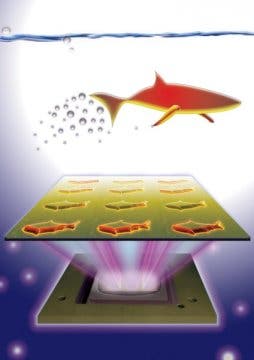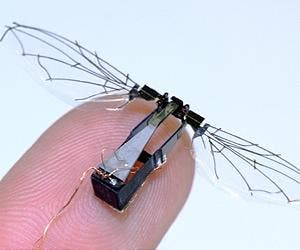Nanoengineers from the San Diego University of California used innovative, self-developed 3D printing methods to create multipurpose, fish-shaped microbots – that they call microfish – which can swim around efficiently through liquids, powered by hydrogen peroxide and are magnetically controlled.

Image credits: J. Warner, UC San Diego Jacobs School of Engineering.
Traditional methods of microrobot construction allow for various locomotion mechanisms to be installed on the tiny chasis: microjet engines, microdrillers or microrockets. Most of these robots are incapable of performing more sophisticated tasks however, due to the simplicity of their design. Being made of homogenous, inorganic materials with simple spherical or cylindrical structures, they do not carry the tools and they do not have the structures required for complex tasks. In this new study, researchers demonstrated a simple way to create more complex microrobots.
The research was led by Professors Shaochen Chen and Joseph Wang of the NanoEngineering Department at the UC San Diego, with their findings published in the August 12 issue of Advanced Materials journal.
What makes these microfish special?

Image via space-travel
Drawing on Professor Wang’s expertise in microrobot design, and Professor Chen’s advances in 3D printing technology, the team’s custom-built microfish are a huge leap from the relatively simpler designs engineers were capable of producing up until now. One of the most useful addition is that the microfish can easily be equipped with several different kinds of functional nanoparticles in specific parts of their bodies. Nanoengineers installed platinum nanoparticles in the tails of the fish, which react with hydrogen peroxide to propel them forward; magnetic iron oxide nanoparticles were embedded into the heads, to allow them to be steered with magnets.
“We have developed an entirely new method to engineer nature-inspired microscopic swimmers that have complex geometric structures and are smaller than the width of a human hair. With this method, we can easily integrate different functions inside these tiny robotic swimmers for a broad spectrum of applications,” said the co-first author Wei Zhu, a nanoengineering Ph.D. student in Chen’s research group at the Jacobs School of Engineering at UC San Diego.
As a proof-of-concept demonstration, the researchers incorporated toxin-neutralizing nanoparticles throughout the bodies of the microfish. Specifically, the researchers mixed in polydiacetylene (PDA) nanoparticles, which capture harmful pore-forming toxins such as the ones found in bee venom. The researchers noted that the powerful swimming of the microfish in solution greatly enhanced their ability to clean up toxins. When the PDA nanoparticles bind with toxin molecules, they become fluorescent and emit red-colored light. The team was able to monitor the detoxification ability of the microfish by the intensity of their red glow.
“The neat thing about this experiment is that it shows how the microfish can doubly serve as detoxification systems and as toxin sensors,” said Zhu.
The team hopes that these proof-of-concept synthetic microfish will inspire a new generation of ‘smart’ microrobots that have diverse capabilities such as detoxification, sensing and directed drug delivery, researchers said.
“Another exciting possibility we could explore is to encapsulate medicines inside the microfish and use them for directed drug delivery,” said Jinxing Li, the other co-first author of the study and a nanoengineering Ph.D. student in Wang’s research group.
Chen’s 3D printing technology
Microfish fabrication is based on a rapid, high-resolution 3D printing technology called microscale continuous optical printing (μCOP), a development of Chen’s lab.
Some of the benefits of μCOP printing are speed, scalability precision and flexibility. Hundreds of 120 microns long and 30 microns thick microfish can be printed within seconds, without using any harsh chemicals. As the μCOP technology is digitized, researchers could easily experiment with various designs for their microfish, even including shark and manta ray shapes. And it doesn’t stop there, either.
“With our 3D printing technology, we are not limited to just fish shapes. We can rapidly build microrobots inspired by other biological organisms such as birds,” said Zhu.
The key component of the μCOP technology is a digital micromirror array device (DMD) chip, which contains approximately two million micromirrors. Each micromirror is individually controlled to project UV light in the desired pattern (in this case, a fish shape) onto a photosensitive material, which solidifies upon exposure to UV light. The microfish are built using a photosensitive material and are constructed one layer at a time, allowing each set of functional nanoparticles to be “printed” into specific parts of the fish bodies.
“This method has made it easier for us to test different designs for these microrobots and to test different nanoparticles to insert new functional elements into these tiny structures. It’s my personal hope to further this research to eventually develop surgical microrobots that operate safer and with more precision,” said Li.


